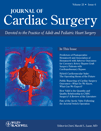The Patency of Sequential and Individual Saphenous Vein Grafts after Off-pump Coronary Artery Bypass Grafting
Conflict of interest: None.
Abstract
Abstract Background: The impact of the grafting techniques (individual or sequential grafts) on the graft patency of off-pump coronary artery bypass grafting (OPCAB) has not been reported. The mid-term patency rates for individual and sequential saphenous vein grafts (SVGs) as coronary bypass conduits of OPCAB were compared. Methods: A total of 714 distal coronary anastomoses on 448 SVGs were assessed using a 64-multislice computed tomography in 398 patients at an average of 26.4 ± 23.6 months (three months to five years) after an OPCAB procedure. The blood flow of grafts in the proximal segment of individual and sequential SVGs was also compared. Results: The overall patency of sequential SVGs (95.9%) was significantly superior to individual ones (90.6%, p = 0.022). The anastomoses on the sequential conduits had better patency (95.1% vs. 90.1%, p = 0.013). The patency of side-to-side anastomoses (97%) was better than that of end-to-side anastomoses (93.1%) and also better than that of the individual end-to-side anastomoses (90.1%, p = 0.002, p = 0.041). No significant difference was observed between the two approaches in regard to the three major coronary systems; however, anastomoses on sequential grafts had superior patency to those on individual grafts in the right coronary system (p = 0.008). The blood flows of double and triple sequential SVGs were significantly higher than those of individual ones (p < 0.001, p = 0.048, respectively). Conclusions: The mid-term patency of a sequential SVG conduit after OPCAB is excellent and generally superior to that of an individual one. (J Card Surg 2010;25:633-637)




